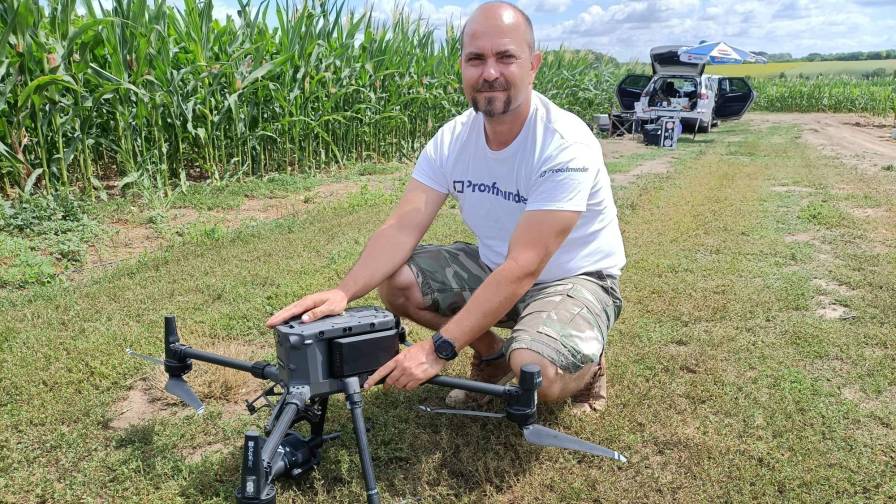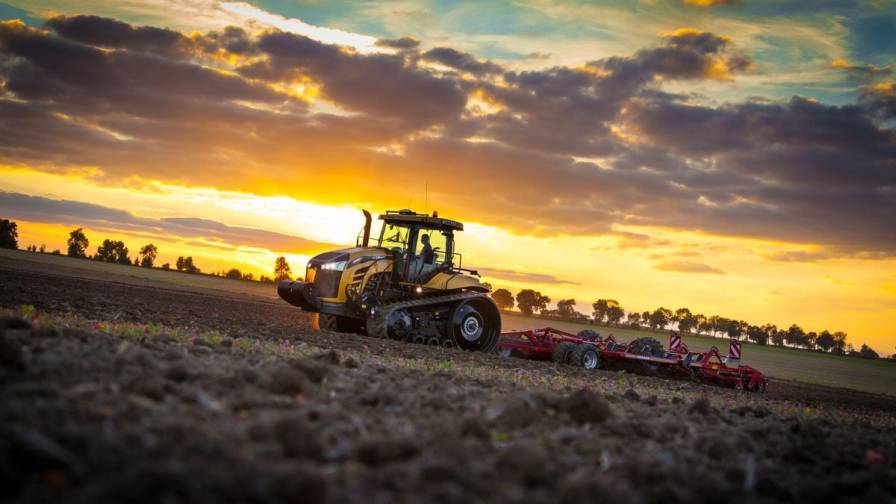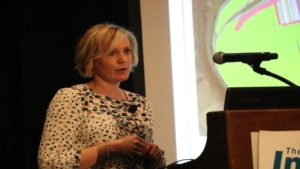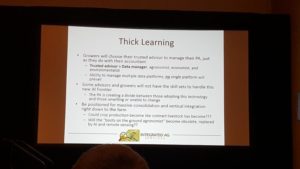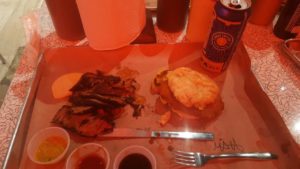InfoAg 2018 Deep Dive: Pixels Over Plastic (OPINION)
InfoAg, precision farming’s annual mid-summer blowout, is about a week in the rearview as I type this, a hazy Midwestern summer morning underway here in Ohio.
Seven days later, and I’m still trying to crystalize what the main takeaway from St. Louis should be. Granted, I only spent a little over 36 hours total at this years show, part of that admittedly the result of my own lingering trade show fatigue hangover (been on a streak since Agritechnica), the other part a bit of personal endeavoring to reign in my usual indulgence into the late-night industry soirre at the hotel bar, but I digress…
Probably the biggest piece of hard news (is there such a thing as “soft news”?) to come out of St. Louis this year was Wednesday’s DataStore announcement by Farmobile, which we covered in-depth here.
MORE BY MATTHEW J. GRASSI
VISION Conference Preview: Someday, AI Might Grow Better Plants than People
2019 Commercial UAV Expo: 3 Quick Revelations From an Ag Drone Expert
Specialty Crops: 8 More Precision Technology Companies We’re Keeping an Eye On
Still, just kicking around the trade show floor and hitting some of the sessions and presentations in the ballrooms, even if for only a couple hours each afternoon, one could come away with some observations and trends forming.
Trade Show Thoughts
- Oftentimes, these shows get so busy with meetings and appointments and the like that, as an ag editor, perhaps we can’t see the forest for the trees right away. Or we can’t see the hand five inches from our faces, basically. Leave it to us so-called journalists, then, to go ahead and do what we always do and lean on our precious “sources.” In this case, I can reveal the source as our longtime friend Jeremy Wilson, a guy that’s been around InfoAg since the Champaign, IL, Holiday Inn days, and has seen his fair share of companies and products come and go from Ag Tech. Wilson grabbed me after the opening night reception had just wrapped, imploring me: “Matt, I need you to look around this trade show floor for me, and then you tell me: where are all the field computers? What happened to all the displays that used to be at this show? I think there’s a story there for you…” Wilson was spot-on. Other than Raven’s new CR7 field computer, and the folks I met from JLT Mobile Computers (Chandler, AZ) – who are tricking up some slick ruggedized displays and tablets specifically for heavy industry – you could say there was certainly a dearth in the amount of in-cab hardware on display at what began as a well, a hardware show. John Deere for its part didn’t have a single piece of hardware – computer, IRON, or otherwise – in it’s booth, and most of its team on hand was the ISG squad, there to talk APIs and data movement, not horsepower or screen resolution. So, what does that mean? It’s just another example of what will become a running theme throughout this write up – precision ag is becoming ever more a data-centric endeavor. Pixels are winning out over plastic. Now, I’m not saying to go back home and toss your GreenStars in the green dumpster out back, it’s just something to keep in mind as you continue to evaluate what technologies make the most sense for your growers.
- Another running thought on the trade show, and this came from multiple sources, both on and off-the-record, throughout my time in St. Louis: “If we thought the InfoAg shows in 2014 or 2015 were ‘The Wild, Wild West’ days of precision ag, what the hell do you call this? This. Is. Insane.” Ok, so that last part in italics is my own editorializing, but I stand by it. I argue it is literally insane how many options, take the remote sensed imagery space alone, for example, a grower or ag service provider must evaluate before pulling the trigger. We’ve been stressing for years that the industry is in technology solution overload, and then you spend an afternoon walking around InfoAg 2018 and you’re barely able to form coherent sentences from the sheer sensory overload of trying to take it all in. Thinking back on it now, I keep circling back to something I heard Integrated Ag Services (Marysville, OH) owner Dave Scheiderer say in his presentation: “It’s my opinion that we’re not going to see a single platform win out (over all the others).” Then my crazy kid from the 90s imagination gets running: “What if Dave is right? What if it’s not one single agronomy solution to rule them all, but rather a coordinated, API’d ecosystem of the best-of-the-best in each category?” Kind of makes ya think, doesn’t it?
Imagine an Imagery Overload of Epic Proportions!
One of my main objectives in St. Louis for the week was to hit all the imagery provider booths – fixed-wing planes, satellites, drones, everything – and see what’s intriguing in what’s currently the most crowded segment of digital farming since the Drone Race days of years’ past.
First up was Taranis, an Israeli-owned outfit that acquired Bay Area, CA-based imagery provider Mavrx back in May. Matthew Rohlik, formerly regional sales manager at Mavrx and now in sales and customer success with Taranis, was my contact there. After hearing how Rohlik basically completed an Aaron Rodgers-esque Hail Mary in engineering what sounds like a last-second hostile takeover, with help from Taranis, of the then-fledgling Mavrx outfit’s assets, I asked Rohlik his thoughts on where imagery is today as an industry, specifically from the standpoint of “How does a service provider looking at his options decide on an imagery provider?”
“Here’s what I’ll say: Ten years ago, this show was primarily GPS auto-guidance, right? A lot of hardware,” Rohlik stated. “So now we’re into what I would call more the data side, with a focus on in-season crop management. Yes, there are a lot of these companies. I think there will be more consolidation happening, cause the market is only so big. When that consolidation happens they’re going to need to have a full stack in-season package that includes some type of in-season sampling or scouting availability, and it’s going to have to have different resolutions – whether that’s plane or satellite or drone – and fast turnaround, otherwise retailers aren’t going to buy it.”
I must admit the Taranis imagery offering itself looks promising, and it’s something I’m hoping to dig deeper into with Rohlik and Co. as they continue their North America rollout. Rohlik did assure me that many of the retail customers that had signed on with Mavrx – for instance the Valley Agronomic guys I visited with back in May out in Oregon – had re-upped with Taranis, many of them on two-year service deals. And Taranis will reportedly be spending much of what’s left of 2018 investing capital in upgrading the fixed wing fleet and sensing capabilities from the assets acquired during the Mavrx takeover.
Another newish to InfoAg imagery player this year that impressed was Airbus, the Touluse, France-based aerospace company that is putting increased focus into its agriculture imaging segment. I attended Sky Rubin’s talk during the Sponsor Showcase, and the company (U.S. headquarters are in Fort Collins, CO) has some really cool and different things coming for ag and ag service providers in particular. One of which is a renewed focus on delivering low resolution, high range and high frequency imagery, meaning the satellite images are of lower detail but able to capture large tracts of land multiple times per day, allowing for potential twice-per-day image delivery.
Then there’s Airbus’ coming HAPS (High Altitude Psuedo Satelitte) Zephyr S drone, which has a 120 foot wing span and can fly continuously for 3-4 months and deliver 10-20 cm resolution imagery from stratospheric altitudes (the freakin’ thing flies at 70,000 feet!). “If we had a fleet of these HABS we could potentially image the entire Corn Belt daily,” Rubin said during his presentation. Retailers and ag service providers will also want to check out Airbus’ API-driven Field Maps product, which Rubin described as a “turn key imagery analytics program served up as an API – meaning it’s designed to be plugged into existing software. With Field Maps we can monitor every single field – there is no limit, and ground truthing is not necessary with this type of service.” I spent some additional time at the Airbus booth, chatting with Rubin about Fort Collins’ craft beer scene, as well as where the young executive sees the imagery space evolving to in the coming years. “We’re starting to see more and more service providers starting to value higher resolution and more premium data and premium systems, especially in terms of scouting…they really want to figure out ‘Is this a water issue, is this a pest issue?’ They want to know what is happening in that field, and they want high-resolution, premium systems, not just the free data.”
EDITOR’S UPDATE (7/26/2018)
Almost forgot, I also met with a new player in the drones in ag space in Toulouse, France-based aerospace engineering firm Delair, a company that began in 2011 with four employees and has since grown to over 120. The group sent a team of reps to St. Louis to kick around the trade show floor and network, having recently opened its U.S. headquarters in Los Angeles, CA, and like its fellow countrymen at Airbus the outfit is reportedly putting increased focus and resources into its agriculture imaging segment.
Lenaic Grignard, agriculture and forestry product manager, told me the company is proficient in “collecting UAV data to enable the building of digital twins of assets” in other industries (it’s processing software is powered by Intel Insights) and believes the approach has a nice fit in U.S. ag. UX11 is the startup’s newest UAV, offering a 60 minute flight endurance and the ability to collect about 520 acres of data when flown at the 400 foot ceiling. Right now the bird only comes with an RGB camera, making it ideal for spot-checks, plant and stand counts, and in-season crop scouting, as well as irrigation equipment inspection and monitoring, and the company plans to offer other spectral sensor options as it makes its U.S. ag debut. Another notable aspect of UX11 is it’s landing sequence, where the bird aggressively dives at a sharp angle before pulling its nose skyward at the last second and gliding to a soft belly landing (kind of like what Denzel did in the movie Flight, minus the upside down part). Honestly, if one of my DJIs ever came down like that I’d be in full cardiac arrest before the thing touched ground, but the landing sequence could prove useful in tight fields surrounded by trees, power lines, or other obstacles.
Service Provider Learnings
Aside from the constant trade show floor hubbub, another valuable part of the InfoAg experience is the ability to network, or “chop it up” as I like to call it, with other like-minded ag service professionals.
A couple of the service provider led presentations stand out for me, one being Agri-AFC’s (Decatur, AL) Amy Winstead, who our friend in Cotton Country Jim Steadman profiled for the cover of PrecisionAg Professional back in August of ’17. A couple things Winstead stressed above all else: ROI (“Profitability is key – at the end of the day you need to be able to go back to the customer and show them that the practice or product increased their profits”) and Service and Support. “Service and support are key to what we do, if you’re going to succeed as an ag retailer you need to fully embrace that, from the top down.”
Dave Scheiderer, the Ohio Ag Leader dealer I mentioned earlier, also had some interesting quotes for ag service providers to consider during his talk. Instead of trying to weave those into a compelling narrative I’ll go the lazy route and just throw them up, bullet-point style, for your inspection:
- “Sixty to 70% of precision ag today is just this: accurate field boundaries with geo-referenced soil test points for variable-rate fertilizer application.”
- “Artificial Intelligence (AI) and machine learning won’t completely displace the farmer-trusted advisor relationship, but it will enhance it. There will still be a very strong need for the trusted advisor, but the trusted advisor of the future will be more data manager than what he or she is today, which is a combination of agronomist, economist, etc. etc.”
- “The AI frontier is upon us in ag and it’s really going to be a game-changer.”
- “One thing I think we need to be aware of as an industry: we’re creating a divide between those adopting these technologies and those unwilling to change. It is my belief that the guys that embrace technology will be the ones farming in the future.”
I asked Scheiderer for some clarity on the agronomist’s changing role in the future. As an ag service provider looking to drive adoption locally among a group of farmers, do we focus on the growers that are seemingly open to adoption, or do we try to convert the skeptical masses?
“It’s really a little bit of both,” Scheiderer answered. “I mean, certainly from an altruistic viewpoint it would be ‘We’re going to help them out.’ From a realistic point of view, some (growers) don’t want the help, and I think we’ve got to be realistic about that. I think the real answer is, as a service provider we’ve got to evaluate that. Is this somebody that is looking for the help? That’s somebody that you want to partner with.”
Random Stats For Service Providers to Consider (via Millenium Research’s PrecisionAg Institute Presentation)
- 76% of row crops growers say that when it comes to evaluating their service provider, priority number one is whether the service provider helped that producer “meet or exceed profit goals” for the year.
- 65% of specialty crop growers answered the same question by saying “peace of mind throughout the growing season that the best practices are being applied” is top priority in evaluating the grower-trusted advisor relationship.
St. Louis Food and Drink Tidbits You Can Skip Over If You Want
Food: Finally, after being shutout on previous attempts, made it to Sugarfire Smokehouse, a chain of upscale, fast-casual BBQ joints that dot the Eastern Missouri/Western Illinois countryside. I can share that the half-pound of smoked brisket plus the ginormous fried buffalo chicken biscuit combination (#TeamNoSides) I tricked up in my boozy, post-reception haze was divine. One small grumble though, as was the case at nearby Pappy’s Smokehouse last year, Sugarfire was completely out of ribs upon our arrival! How come these St. Louis BBQ joints can’t keep ribs on the damn shelf long enough for us to get a little taste of that heavenly pork goodness? I DEMAND PROPERLY SMOKED FATTY PORK RIBS UPON MY RETURN TO ST. LOUIS…What gives, St. Louis BBQ Guys?
 Beer: Urban Chestnut Brewing Company’s Fantasyland IPA is yet another notable and dank IPA offering in the ever-ubiquitous 16 oz. can format. I give this beer, and the craft brewing industry’s penchant to slam as much high-gravity hop juice into a 16 oz aluminum can as humanely possible, five out of five stars! Keep those Tall Cans coming, you guys!
Beer: Urban Chestnut Brewing Company’s Fantasyland IPA is yet another notable and dank IPA offering in the ever-ubiquitous 16 oz. can format. I give this beer, and the craft brewing industry’s penchant to slam as much high-gravity hop juice into a 16 oz aluminum can as humanely possible, five out of five stars! Keep those Tall Cans coming, you guys!









